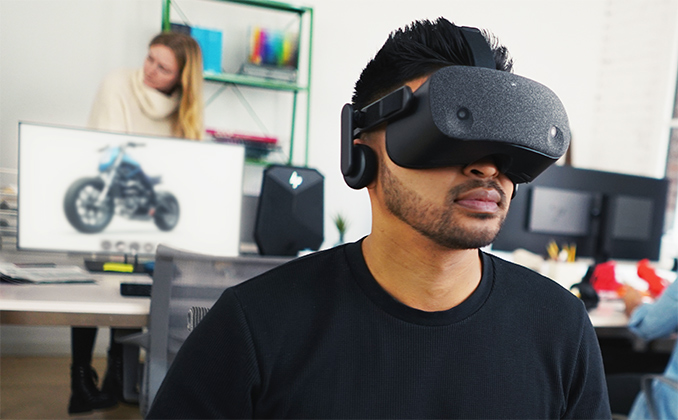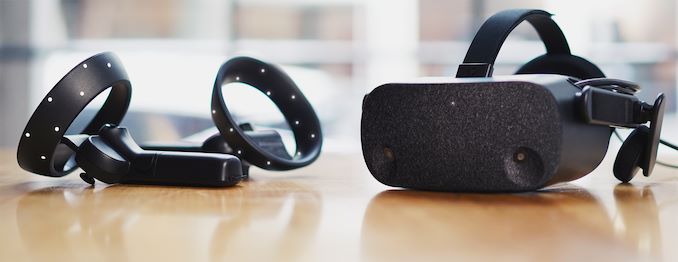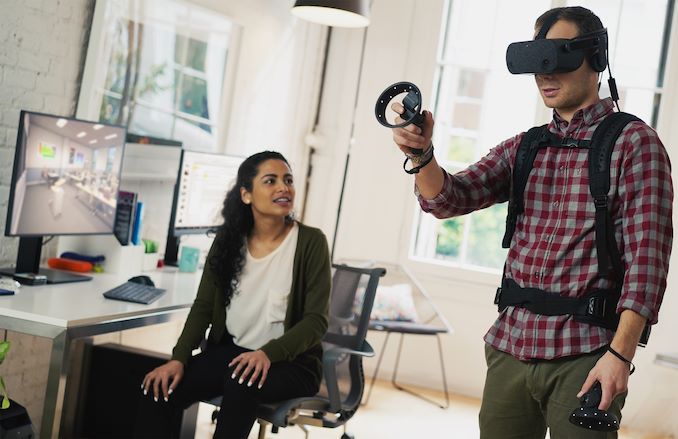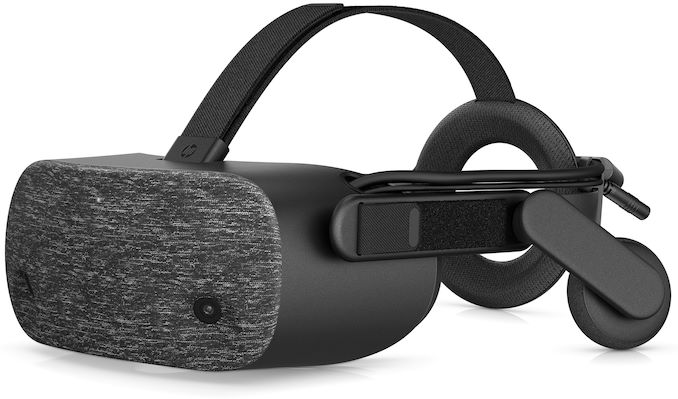HP Reverb Virtual Reality Headset: A 4K HMD with 6DOF
by Anton Shilov on March 20, 2019 5:00 PM EST
Numerous companies are making attempts to drive VR technology to the commercial space. HP this week introduced its first AR/VR headset that was designed from the ground both for consumer as well as for commercial/professional applications.
The HP Reverb VR headset is outfitted with two 2.89-inch screens featuring a 2160×2160 resolution per eye (4320×2160 combined resolution), a 90 Hz refresh rate, and a 114-degree field of view. The head mounted display (HMD) comes with a built-in inside-out 6-degree-of-freedom (6DoF) positional tracking and therefore does not need any external sensors. It also has its own spatial audio headset, and two front-facing cameras to enable augmented reality applications. The device also comes with Bluetooth connected motion controllers that are pre-synced to the headset to simplify setup.
To make the Reverb VR HMD more comfortable to use, HP outfitted it with a rather unique adjustable headstrap featuring a built-in cable management and enhanced ergonomics to compensate the weight and ensure that the headset does not fall.
HP’s Reverb headset requires a rather powerful PC with a DisplayPort 1.3 connection to ensure proper performance at a 4320×2160 resolution with a 90 Hz refresh rate. HP says that the head-mounted display is fully compatible with its Z VR wearable backpack PC, but keep in mind that certain programs might need a high-end graphics card only found in gaming/workstation desktops.
The HP Reverb VR headsets — both the Professional and Consumer Editions — can work perfectly with Windows Mixed Reality, and SteamVR applications (which are mostly games). The only hardware difference between the two versions is their bundle: the Pro model comes bundled with a 0.6-meter cable for HP's Z VR Backpack PC as well as a cleanable face cushion.
HP will start selling its Reverb VR headsets in late April. The consumer version will cost $599, the price of the professional model will be disclosed at a later date. Both HMDs will be covered with a one-year warranty with optional care packs for the Pro flavor.
Related Reading:
- Japan Display Develops VRM-100 VR Headset with 3DOF for Business Users
- HP Windows Mixed Reality Headset, Professional Edition, Coming March
- VR Startup Varjo Announces Shipping of High Resolution Headset Prototype, Aimed at Professional Markets
- Windows Mixed Reality Headsets Gain SteamVR Support, a Library of VR Games
- HP Expands Commercial VR Strategy: Z VR Backpack and Immersion Centers
Source: HP















42 Comments
View All Comments
nandnandnand - Wednesday, March 20, 2019 - link
The target for headsets should be 220° horizontal, 150° vertical. 200° horiz, 135° vert. at minimum. Add foveated rendering to reduce rendering burden.andyveryhandy - Wednesday, March 20, 2019 - link
Human horizontal FOV is basically 114 degrees. Vertical is higher, around 180 degrees I think, not sure. I can’t think of a single instance in which we would want VR FOV to be greater vertically than horizontally. That’s not how human vision works.A 200 degree horizontal field of view is more than 180! You’d be seeing things that are *behind* you.
I think you might be confusing 360 video with viewing that content, but still don’t understand the argument behind lowering vertical FOV.
vertigo7272 - Thursday, March 21, 2019 - link
Human vision actually is slightly more than 180 degree horizontally. You seem to forget we have 2 eyes. Most people can detect movement to about 210 degree. More over, we can actually move our eye balls, which gives us even greater Fov, nearly 270 degree. just try it, spread you arms and literally see what happens.Valantar - Thursday, March 21, 2019 - link
You've got that entirely turned around. Human horizontal FOV is around 200-220°. Remember, 114° is barely wider than 90°. Are you claiming you can only see in a cone right in front of you? That's not how human vision works. And yes, your peripheral vision can indeed pick up things slightly "behind" you, even if all you're likely to register in that range of vision is movement.The focal area of human vision is far smaller than this, but peripheral vision is crucial to our perception of space (and thus likely also avoiding VR nausea!), and indeed for our perception of our surroundings more generally too. This is also why we need eye-tracking foveated rendering, as our eyes dart around within this wide field quite a lot. The outer 20-40 degrees could likely be rendered at 1/8th the resolution (and probably reduced texture complexity and color depth too) of the focal area, but without eye tracking that would be horrible.
Applejackson - Wednesday, March 20, 2019 - link
Lol. Those numbers don't make any sense.gighgihg - Thursday, March 21, 2019 - link
I like when you guys say "add foveating rendering"as if any of the extant eye tracking solutions even have it working well or any games support it.oddity1234 - Friday, March 22, 2019 - link
Foveated rendering does not require any game support. The eye tracking hardware in the headset communicates directly with the GPU, telling it which parts of the image need to be rendered at full resolution. At no point does the application/game need to know what's going on. In fact, communicating with the application layer would probably be far too slow anyway; foveated rendering is even more time-sensitive than standard VR.Alexvrb - Wednesday, March 20, 2019 - link
As Jaxad said, 114 degrees, actually. Plus some fancy-pants asymmetrical lenses. The headphones are removable, and it looks like they have weight/comfort/breathability under control. Eye tracking would have definitely raised price and isn't mission critical. Seems like they pretty much nailed it at this price point... I echo your sentiment about HP taking the lead. I did not see that coming.Unfortunately the sweet spot price for me is a bit lower, but they're going after the premium VR crowd. Perhaps they will release a cost-reduced version at some point, or else I'll be picking up an Odyssey / similar on sale around the time MW5 Mercs hits.
Valantar - Thursday, March 21, 2019 - link
I agree that the price is still high (price has kept me out of VR until now, and even if this is better in terms of price/features it's still quite a bit of money - too much for me to do more than consider saving up for it), but compared to the Vive Pro? Better features for noticeably less. Rift? Far better features for only slightly more money. I'd say this is where "premium" headsets should be in price (for them to sell decently), and this finally comes close to the featureset to match the price.In a few years I hope we have mainstream headsets around this feature level for $300 or so (with the $600 ones having eye tracking, foveated rendering and wide FOV), but for now, this is a big step in the right direction.
Alexvrb - Friday, March 22, 2019 - link
Yeah. As I said, they nailed it at THIS price point. So while I have huge respect for the Reverb, and I think it mops the floor with the competition, all of these models are more money than I want to spend for a part-time display. Samsung has the first gen Odyssey on sale direct for $250 which is more my speed. But by the time MW5 Mercs hits, I'm hoping a better option will be in the $300 range.